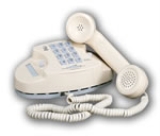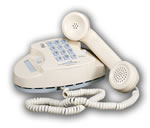
Princess telephone
Encyclopedia
The Princess Phone was introduced by the Bell System
in 1959. It was a compact telephone designed for convenient use in the bedroom, and contained a light-up dial for use as a night-light. It was commonly known with the slogan "It's little...It's lovely...It lights", which was suggested Robert Karl Lethin. Its dial was in the base of the telephone. Contemporary advertising demonstrates that this telephone was marketed to women, hence the feminine designation 'Princess'. As a result, a broad range of colors were offered, including pink, red, yellow, moss green, black, white, beige, ivory, light blue, turquoise, and gray.
The designer of the Princess was the famed industrial designer Henry Dreyfuss
, working closely with the engineers at Bell Laboratories. Later redesigns were done by Donald Genaro of the Dreyfuss design firm (Genaro redesigned the case so that it could be more easily picked up).
The Princess was unique in two aspects: it required an external electric transformer to power the light-up dial, and when the telephone began production, Western Electric did not have a ringer small enough to fit inside the case; an external ringer was required.
Early versions of the Princess were known as 701B series phones. These required an external ringer. Customers complained that the phone was so light that it would slide around on surfaces while dialing, so an optional lead weight was added.
Later models included the M1A ringer. The rotary dial version was known as the 702B (the modular version would be labeled 702BM). Another model of the Princess was the model 711B, a slide switch /push-button, two line phone with exclusion on line 1. A ten button Touch Tone version was known as the 1702B, while the standard twelve button arrangement was known as the 2702B (modular version was the 2702BM). Several other variations were made and can be viewed on this external site.
The telephone was produced at the Western Electric
Indianapolis, and later Shreveport Works plant, also the location of 500/2500 series
telephone production. The Trimline telephone
is often confused with the Princess because the Trimline dial lights up, even though the dial on the Trimline is in the handset.
The Princess underwent several changes in its production run:

In 1994, AT&T ended production of the Princess telephone. It continues to lease the Signature Princess model. Due to its removal from production, and its attractive design, the Princess has become an extremely collectible phone. Princess telephones in pink, turquoise, and black are among the rarest colors of the phones and most valuable.
During the 1960s and 1970s, this was by far the most common design used for toy telephones.
Automatic Electric offered a lighted-rotary-dial model of similar proportions but a rectangular (rather than elliptical) footprint, called the "Starlite Phone," and later offered a non-lighted 12-key touch-tone model simply called the "Desk Compact."
Bell System
The Bell System was the American Bell Telephone Company and then, subsequently, AT&T led system which provided telephone services to much of the United States and Canada from 1877 to 1984, at various times as a monopoly. In 1984, the company was broken up into separate companies, by a U.S...
in 1959. It was a compact telephone designed for convenient use in the bedroom, and contained a light-up dial for use as a night-light. It was commonly known with the slogan "It's little...It's lovely...It lights", which was suggested Robert Karl Lethin. Its dial was in the base of the telephone. Contemporary advertising demonstrates that this telephone was marketed to women, hence the feminine designation 'Princess'. As a result, a broad range of colors were offered, including pink, red, yellow, moss green, black, white, beige, ivory, light blue, turquoise, and gray.
The designer of the Princess was the famed industrial designer Henry Dreyfuss
Henry Dreyfuss
Henry Dreyfuss was an American industrial designer.-Career:Dreyfuss was a native of Brooklyn, New York. As one of the celebrity industrial designers of the 1930s and 1940s, Dreyfuss dramatically improved the look, feel, and usability of dozens of consumer products...
, working closely with the engineers at Bell Laboratories. Later redesigns were done by Donald Genaro of the Dreyfuss design firm (Genaro redesigned the case so that it could be more easily picked up).
The Princess was unique in two aspects: it required an external electric transformer to power the light-up dial, and when the telephone began production, Western Electric did not have a ringer small enough to fit inside the case; an external ringer was required.
Early versions of the Princess were known as 701B series phones. These required an external ringer. Customers complained that the phone was so light that it would slide around on surfaces while dialing, so an optional lead weight was added.
Later models included the M1A ringer. The rotary dial version was known as the 702B (the modular version would be labeled 702BM). Another model of the Princess was the model 711B, a slide switch /push-button, two line phone with exclusion on line 1. A ten button Touch Tone version was known as the 1702B, while the standard twelve button arrangement was known as the 2702B (modular version was the 2702BM). Several other variations were made and can be viewed on this external site.
The telephone was produced at the Western Electric
Western Electric
Western Electric Company was an American electrical engineering company, the manufacturing arm of AT&T from 1881 to 1995. It was the scene of a number of technological innovations and also some seminal developments in industrial management...
Indianapolis, and later Shreveport Works plant, also the location of 500/2500 series
Model 500 telephone
The Western Electric model 500 telephone series was the standard desk-style domestic telephone set issued by the Bell System in North America from late 1949 through the 1984 Bell System divestiture. Millions of model 500-series phones were produced and were present in almost every home in North...
telephone production. The Trimline telephone
Trimline telephone
The Western Electric Trimline telephone is a variety of telephone set designed by Donald Genaro of Henry Dreyfuss Associates for the Bell System . It was built by the Bell System's manufacturing arm, Western Electric. The idea behind the Trimline telephone was to create an alternative telephone...
is often confused with the Princess because the Trimline dial lights up, even though the dial on the Trimline is in the handset.
The Princess underwent several changes in its production run:
- In 1963, the Bell SystemBell SystemThe Bell System was the American Bell Telephone Company and then, subsequently, AT&T led system which provided telephone services to much of the United States and Canada from 1877 to 1984, at various times as a monopoly. In 1984, the company was broken up into separate companies, by a U.S...
introduced touchtone dialing, and Western Electric began production of a touch-tone model, with 10 numerical keys (lacking today's * and # keys). The internal network of the Princess was reduced in size the same year, allowing a small, quiet bell ringer to be placed to the left of the touch-tone dial. - In the mid 1970s, AT&T introduced "modular" telephone plugsModular connectorModular connector is the name given to a family of electrical connectors originally used in telephone wiring and now used for many other purposes. Many applications that originally used a bulkier, more expensive connector have now migrated to modular connectors...
, with the RJ11 standard home telephone jack. Most customers who had Princess telephones were converted to modular jacks. - In 1983, AT&T was preparing itself for divestiture of the Bell SystemBell SystemThe Bell System was the American Bell Telephone Company and then, subsequently, AT&T led system which provided telephone services to much of the United States and Canada from 1877 to 1984, at various times as a monopoly. In 1984, the company was broken up into separate companies, by a U.S...
. It started American Bell, a separate sales subsidiary of Western ElectricWestern ElectricWestern Electric Company was an American electrical engineering company, the manufacturing arm of AT&T from 1881 to 1995. It was the scene of a number of technological innovations and also some seminal developments in industrial management...
and the Bell Operating Companies. AT&T introduced a non-light up dial with white keys to be sold in Phone Center Stores (these sets were marked "CS" on the bottom for "consumer sales"). Post-divestiture colors added after 1984 included slate blue and light green.

- In 1993, the Princess was heavily redesigned. Although it retained the same handset & oval shape it has had since its introduction, a new dial was introduced. The dial still required an external transformer for night-light use; a handset volume control was added to the dial pad; phone number "card" was moved from below the dialpad to the location of the rest for the microphone. This model was called the "Signature Princess", and was freely available for lease; only available for purchase at AT&T Phone Centers, which closed in 1996.
In 1994, AT&T ended production of the Princess telephone. It continues to lease the Signature Princess model. Due to its removal from production, and its attractive design, the Princess has become an extremely collectible phone. Princess telephones in pink, turquoise, and black are among the rarest colors of the phones and most valuable.
During the 1960s and 1970s, this was by far the most common design used for toy telephones.
Automatic Electric offered a lighted-rotary-dial model of similar proportions but a rectangular (rather than elliptical) footprint, called the "Starlite Phone," and later offered a non-lighted 12-key touch-tone model simply called the "Desk Compact."
External links
- Western Electric Princess Telephone Models
- Princess Telephone at Bell System Memorial - A comprehensive page on princess telephones
- Western Electric Telephone Models

